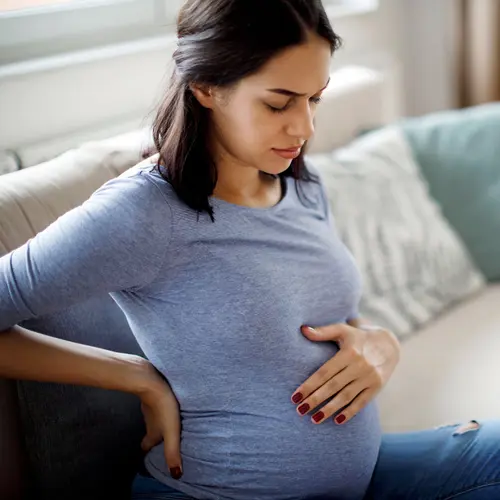Varicose veins are very common. For most women, they are usually a harmless result of pregnancy. Pressure from the uterus on the circulatory system causes blood to back up on the way back to the heart from the legs. Such varicose veins can be easily managed and eventually should go away.
What Are Varicose Veins?
About half of women notice enlarged or abnormal dilation of the superficial veins of their legs while pregnant. These are varicose veins.
Superficial veins in the leg have one-way valves. They help to move blood up the leg against the pull of gravity to return blood to the heart. During pregnancy, many physiological changes occur, including the enlarging of those veins, which become visible. Another physiological change is the growth of the uterus, which affects the main blood vessels.
Varicose Veins Pregnancy Cause
Varicose veins are usually hereditary. Your mother may have had them too, and not much can be done to prevent them.
During pregnancy, blood volume in the body increases. It can increase by up to 20 percent. The number of veins remains the same, though, meaning that there is more work for your limited vascular system.
Spikes in your hormones like progesterone, meanwhile, relax the ligaments of the pelvis and the muscle cells in the walls of the vein. This makes the upward movement of blood more difficult during pregnancy.
As a result, veins dilate, which places pressure on the valves. This causes the veins to dilate even more, making the valve almost useless.
The veins can become itchy and uncomfortable. Though usually found in the legs, varicose veins can also show up in the genital area and as hemorrhoids in the rectum.
Varicose Veins Pregnancy Symptoms
Varicose veins appear as twisted, large, raised bluish/purplish veins in the legs. They often appear on the inside of the legs or back of the calves. They may cause:
- Mild swelling in the feet or ankles
- Aching
- Throbbing in the legs
- Heaviness
They can cause leg cramps. Some may also consider the veins a cosmetic issue. Regardless, you should let your OB-GYN know that you have them. This is especially important if they cause discomfort.
Rarely, venous insufficiency can occur. This is the failure of the veins to return the blood to the heart sufficiently, and therefore, the skin begins to break down. Other rare scenarios include inflammation of the veins, which causes extreme pain and possible blood clots.
Pregnancy Varicose Veins Treatment
Compression stockings are a good treatment and support for varicose veins. They come in many styles, strength levels, and sizes. They can be purchased online, but a prescription submitted by your doctor to a medical supply store can give you a stronger option. Just make sure they are not too strong.
The stockings are graded by pressure value with a measurement of millimeters of mercury (mmHg). Doctors recommend anywhere from 20 to 30 mmHg strength, which is considered moderate- to high-pressured. The lowest strength available is 8 15 mmHg.
Warning: Some moms have tried horse chestnut extract (with esculin, which is poisonous, removed). Please note that eating the flower, raw bark, leaf, or seeds of this plant instead of the extract is poisonous and can be fatal. In fact, the safety of the use of horse chestnut extract, even with the poison parts removed, is unknown. So, it is best to avoid it while pregnant or breastfeeding. Doctors discourage the pursuit of elective surgery to get rid of the veins during pregnancy. The veins usually fade after birth.
How Can You Prevent Varicose Veins?
Several things can be done to avoid varicose veins, avoid making them worse, and reduce vein pain:
- Keep your feet elevated often.
- Engage in daily low-impact exercises with your doctor's approval.
- Take regular breaks and move back and forth as much as possible after extended periods of standing or sitting.
- Keep your legs uncrossed while sitting.
- Sleep with your body turned to the left side to keep pressure off the inferior vena cava, which is located on the right side of the body.
- Wear maternity hose that supports your legs.
You could try these practical adjustments as well:
- Decrease your intake of salt to minimize swelling of the veins.
- Drink a lot of water, and eat plenty of fiber to stop constipation.
- Avoid wearing high heels. It is wiser to wear flat shoes or low heel shoes because this exercises the calf muscles, aiding in better circulation.
Is a Hemorrhoid a Varicose Vein?
Both varicose veins and hemorrhoids are twisted, swollen veins. They are called hemorrhoids when they are found in the rectum. They can get worse with straining or pushing that comes with constipation. If you were overweight before pregnancy, hemorrhoids can become worse during pregnancy. Pushing during delivery makes them worse as well.
Hemorrhoids can form inside of the rectum internally or outside of the rectum externally around the anus. Internal hemorrhoids can grow and bulge through the opening of the anus. The bright red blood that appears during a bowel movement is the most common symptom of hemorrhoids. Hemorrhoids can be itchy, or they can be painful and bleed if they are irritated by wiping and straining.
Do Varicose Veins Go Away After Pregnancy?
Varicose veins are usually harmless, though they could become uncomfortable and itchy. They typically go away within 3 months after giving birth. In the majority of cases, moms walk away from pregnancy with varicose veins that, if not completely gone, are less painful and prominent.
Again, varicose vein surgery is not suggested during pregnancy because they usually automatically improve after birth. However, if the veins become tender, warm, red, swollen, or if they bleed, you should immediately contact your doctor. If the skin of the leg thickens or changes color, or if you develop a rash, it is similarly important to seek medical attention.


